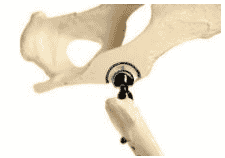Ortho THRs
Total Hip Replacement (THR) Information
Hip Dysplasia
What is it?
Hip dysplasia is the most common non-traumatic orthopaedic condition of medium to giant breed dogs. There are considerable welfare implications and it is unfortunately often overlooked. Dysplasia commences as a puppy as a result of environmental and genetic factors. It is progressive and gets worse throughout life. The condition is often not seen early enough and patients are usually considered to be coping well.
Hip dysplasia and its consequences are diagnosed on the basis of questioning you the owner about exercise tolerance along with clinical examination and radiographs.
Treatment options
These can be divided into conservative and surgical options.
Conservative management involves lifestyle changes to minimise the discomfort associated with the degenerative joint disease. Anti- inflammatory medications are often used for pain relief and to try and slow progression of the condition. Hydrotherapy may be beneficial to keep the musculature surrounding the hips in good shape as well as weight management. Exercise should be continued but may need to be restricted to stop the lameness worsening. Surgical treatment options can be divided into:
• disease modifying (at a very early age before onset of significant symptoms)
• palliative (once symptoms present to try and prevent progression of the condition)
• elective salvage The salvaged procedure of choice is a total hip replacement (THR). There are several systems available.
At Paragon we use the Kyon “Zurich” cementless system for larger dogs and the Biomedtrix cemented micro and nano systems for small dogs and cats.
THR
A total hip replacement involves effectively replacing the ‘ball and socket’ of the hip joint. A stem is inserted into the femur (ball side) and screwed into position. A cup is placed into the acetabulum (socket side). Finally, a head is then placed on the stem and this replicates the normal function of the hip joint.

Choosing when to perform a THR depends on the patient. Young dogs can have a replacement but must be sufficiently mature in size to allow for the implants. Any dog with progressive arthritis could have a THR even much older patients. Other conditions that may contribute to lameness would need to be excluded first.
Surgery risks and complications
THRs are a technical procedure with numerous potential risks attached to them. The most common issue is luxation (dislocation) of the implants. In these circumstances this can usually be revised. Loosening of the cup can occur and could require further surgery. Fracture of the femur is uncommon but could be catastrophic and can be prevented in most cases. Infections are rare but very significant and could require removal of all implants. Breakage of the implants is very rare but could be resolved with further surgery. It is possible for some patients to wear out the cup, which would mean further surgery to replace it. Giant breed dogs are at higher risk for complications, particularly luxation.
Postoperative care and your responsibility as the owner
Before we proceed with a THR on your pet you must agree to our recommendations, as this will minimise the chances of complications in the future. We will not be able to cover the costs of complications caused as a result of not following these instructions.
Your dog will be discharged with analgesia (pain relief) medications. Please administer these as directed.
•An Elizabethan collar must be worn for the first 2 weeks as it is very important that your pet does not interfere with the wound. Should the skin become infected there is a possibility this will extend to the implants. This could result in further surgery to remove all implants.
•Once your pet is discharged they should be strictly rested for 2 months. This means confinement in a cage or small room. You may need to purchase or hire a cage of suitable size. It is a good idea to accustom your dog to this before surgery if this is possible.
•Exercise will consist of 5 minutes lead walking 2-3 times daily for the first 2 weeks. We will ask to see you and your pet at this point to determine if additional exercise is allowed.
•Laminate or slippery surfaces should be avoided or covered temporarily, a slip could result in dislocation or fracture to the site.
•Stairs should be avoided. A support belt/sling is useful in the first week when walking as this will reduce stress on the implants.
•We do not recommend physiotherapy for THR cases.
•Visitors should be instructed not to encourage excitement during visits. Children in the house should be informed of the temporary restrictions and the importance of following these.
•For the first 2 months playing should be strictly limited and therefore we advice that you avoid contact with other dogs to avoid injury.
Re-examination appointments
We will ask to see you and your pet at 2 weeks post-surgery and again at 2 months post-surgery. This second recheck will involve radiography to assess the implants and the healing of the bones. You will need to starve your pet in the morning before this appointment. If all is well then exercise can be increased further, which the surgeon will discuss with you at discharge. Additional rechecks are required at 6 and 12 months and then every 1-2 years after that. By seeing you back and taking radiographs each time we may be able to spot problems occurring early on that would be easier to deal with.
If you have any queries we are always happy to answer them.
